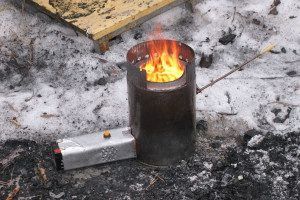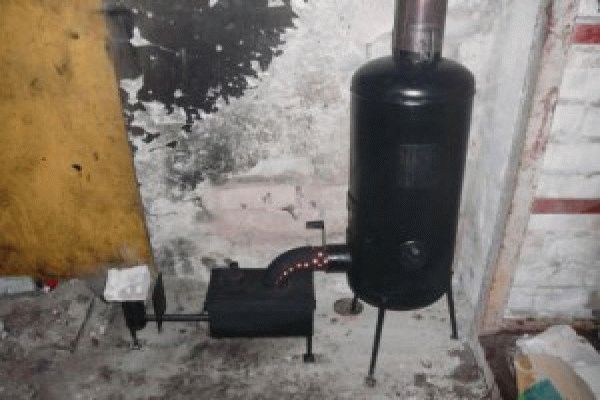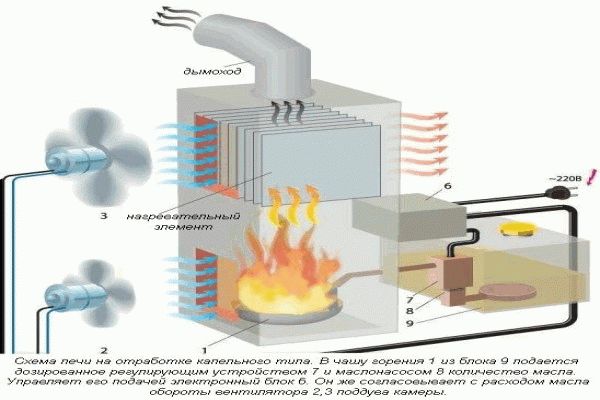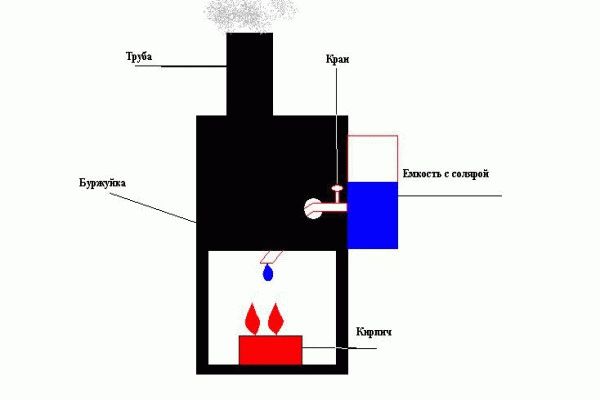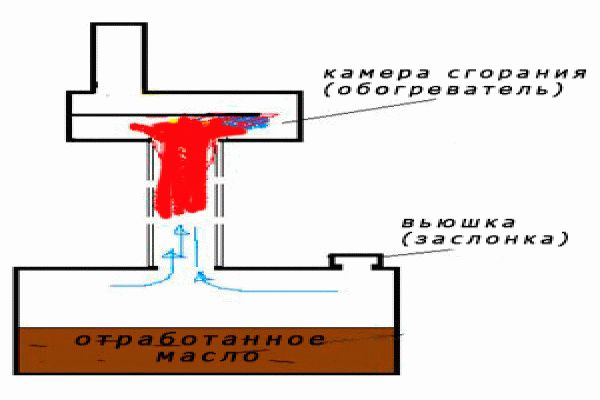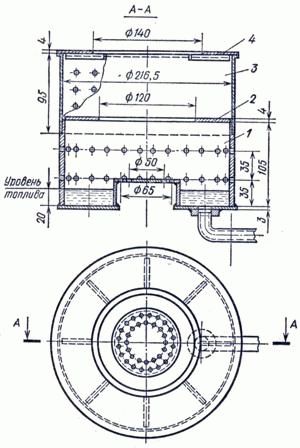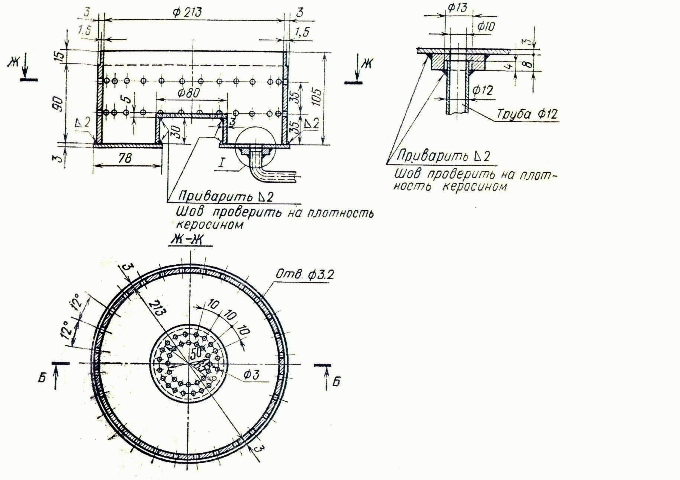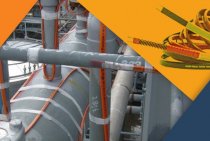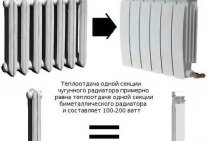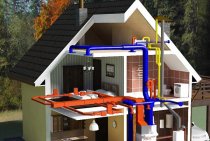Solar oven for garage
The drip stove is relevant for basements, small rooms, a country house, a garage, a greenhouse, where there is no heating and electricity.
Building a stove with your own hands is a fairly affordable and inexpensive activity. How to make a diesel fuel drip oven on your own will be discussed in our article.
Distinctive features
A do-it-yourself stove has a number of advantages:
- it saves fuel;
- if desired, you can design an oven of any size, which will be the most suitable option for a given room;
- easily transported;
- ease of use;
- oven dropper can be used for cooking. To do this, when designing the stove, the pipe is placed on the side.
Scheme of a diesel fuel dropper furnace. This is a very economical design. Complete combustion of compounds occurs in the furnace chamber
When making a do-it-yourself dropper furnace, you need to follow the fire safety technique:
- the device should be located in a room without drafts;
- flammable objects should be absent near the stove, it is desirable to have free space next to it (about half a meter);
- Do not use water to extinguish or cool the stove.
Materials that will be needed for the construction of the furnace:
The main tools that are useful for work are a welding machine, a drill and a clamp.
A popular do-it-yourself device is a drip stove from a gas cylinder
The principle of operation of the device
In the lower tank, the fuel boils after five minutes of operation. Oil vapor enters the next compartment, which is called the burner. There, for better combustion, the steam is enriched with oxygen.
The principle of drip feeding into the bowl (click on the picture to enlarge)
Then, the combustion products enter the upper compartment, and from there into the chimney. The highest temperature is in the upper module of the drip furnace.
Self-manufacturing
To do this, you need a tank of at least 2 liters. There will be no smoke and soot during the operation of the stove. In the process of igniting the stove - it will be, therefore this process is recommended to be carried out on the street.
Diesel fuel from the fuel tank enters the wick cup. With the help of the dispenser, you can adjust the amount of incoming fuel. In the combustion cup, the fuel is heated to form a gaseous mixture, which then enters the combustion chamber. The spiral, which is located at the top of the chamber, is heated to a temperature of 800 ° C. The smoke escapes through the chimney.
You can independently make a device weighing six kilograms. Diesel fuel is a fuel with a sufficiently high density, so its consumption is minimal. In general, such an oven is an efficient and easily transportable design.
Waste oil stove
One type of cheap fuel is used oil. The stove can heat up to 800-900 °C. At the outlet, the temperature will be 90 °C.
Pour in a portion of oil and add 50-100 g of a kindling agent (special fluid, heating oil, kerosene or diesel fuel). This is necessary for quick ignition of the furnace. Wait until the combustion process stabilizes. Then you can pour the next portion.
If there is spilled oil, it must be removed immediately. Combustion takes place inside the pipe. This is a safe process. Fuel consumption from 0.5 to 1.5 liters per hour. When the stove flares up, you can heat the water.
Waste oil stove
Recommended for use: solar oil, fuel oil, waste oil, heating oil. Do not use - gasoline, acetone or other solvents. Water must be avoided in the fuel.
In the specialized literature there are a large number of detailed instructions on how to make a do-it-yourself drip oven.Each of these designs is unique, has its own advantages and disadvantages. You can also use the store version of the stove, but modify it at your discretion.
About security
Even the “correct” home-made diesel stove does not exist from the point of view of fire safety rules - the PPB directly prohibits the use of home-made heating devices for liquid and gaseous fuels. The mere presence of such a unit in the household renders any insurance against fire, explosion and poisoning by volatile substances invalid, and its owner and possibly the manufacturer, guilty of all consequences of any accident due to the stove. Therefore, the task of manufacturing a home-made diesel stove is reduced to purely technical measures to ensure its safety; the formal side is entirely your risk.
Solar vapors should be mentioned in more detail. Not only are they stinky, they are toxic, carcinogenic, and even impregnate old concrete. Therefore, for residential premises, food storage facilities, greenhouses, premises for keeping livestock and poultry, only and only an industrial diesel stove certified for these operating conditions is definitely suitable, and not stationary for temporary use.
Stationary liquid fuel heaters for an individual house are produced and can be manufactured independently, taking into account - see above. But in this case, they must necessarily be double-circuit, i.e. transfer heat from fuel combustion to the coolant, and be located in a fireproof annex with a separate, i.e. from the street, entrance.
Design examples
Potbelly stove
The easiest way is to remake a stove-potbelly stove for diesel fuel. Thermal power will be up to 5-7 kW at a fuel consumption of 300-500 ml/hour. Fuel equipment of the same design can be used practically without changes in more powerful heating boilers running on diesel, as well as for starting on mining and kerosene.
The scheme for refining a potbelly stove for diesel fuel is given in fig. below. Deflectors prevent fuel vapors from cooling down before they burn out. By the way, deflectors increase the efficiency of the stove when starting on wood and coal. The height of the side of the flame bowl is 60-80 mm; its capacity should not be less than the capacity of the nutrient reservoir (see below). The course of the liquid fuel stove, so to speak, is reversed: air enters the wide open door of the firebox; blower closed. Otherwise, the stove becomes voracious and quickly cokes (accumulates with soot).

How to convert a potbelly stove to liquid fuel
Power, start and run
A diesel fuel drip oven will be safe enough and will show all its advantages only if the fuel equipment is assembled and adjusted correctly. The drip furnace is supplied with a mandatory 2-stage, with a buffer feed tank. The reason is a rather strong dependence of the droplet frequency on the outside temperature and pressure in the supply pipeline. The pressure, in turn, is determined by the level of fuel in the tank or the degree of its pressurization. It dripped less often - the evaporator cooled down, the stove went out, the bowl overflowed and the fuel flowed out. It dripped more often - the drops do not have time to evaporate, there is a smoky flame in the bowl, the stove eats fuel in vain. If there is no nutrient reservoir, it can even lead to trouble: a flaming stream will flow from the stove. Therefore, the manufacture and launch of liquid fuel stoves with a single-stage power supply is an occupation for rabid extreme people or those who have nothing more to lose, but really want to sleep.
Both capillaries (see Fig.) are made of red copper. The point here is the wettability of the metal with fuel: it will either not leak through a narrow tube made of another material, or the power supply system will not be able to be established. Establishment begins with the selection of the length of the safety capillary dia. 1.5 mm. The volume of the nutrient reservoir is required 0.25-0.5 l; its height is 7-12 cm.The length of the safety capillary is adjusted so that when the nutrient reservoir is filled to the top, the drop frequency is 25-30 drops per 10 s.
Further adjust a nutritious capillary to dia. 0.6 mm; the fuel in the tank must be filled to full pressure H. With the needle valve fully open and the minimum permissible outside temperature, the frequency of drops from the fuel line to the supply tank should be 2-3 drops per 10 s less. The same droplet frequency is set with a needle valve when the furnace is started at a higher outside temperature.
To start the furnace, a burning wick is placed in the fire bowl (see above). When it burns out, as it should, pour fuel into the feed tank and let drops from the fuel line. The stove will be on the go for 4-5 hours; if a shorter heating time is required, the needle valve is closed. Only from the feed tank, the operation of the furnace will last 1-1.5 hours.

Drawings of a stove with a heater suitable for modification to diesel fuel
for garage
Solar furnace and mining for the garage
A solar furnace for a garage should also be started during testing. The optimal design of the garage miracle oven is shown in fig. on right; the flame bowl for dripping (pulled out) is also a container for non-pressure combustion of oil. Power - up to 5 kW per afterburner column (riser), but making a stove for more than 2 risers is unacceptable, it can explode! Design data:
- Materials - a square corrugated pipe 180x180x6 for the sunbed (combustion chamber) and afterburner, and 100x100x6 for risers.
- The length of the bed is 380 mm, the afterburner is 1000 mm, the height of the risers is 500 mm.
- Holes in risers with a diameter of 10 mm on all 4 sides, 8 evenly along the axis.
- To start the furnace for mining, the feed tank must be disconnected, and the dropper pipe must be plugged from the outside.
- A separate deflector is not needed, it is the sunbed cover.
Do-it-yourself solar oven
Equipment for heating non-residential premises, running on diesel fuel or waste oil, can be made on your own from improvised materials. The home-made design has the simplest device, designed for production in artisanal conditions. The work will require affordable materials and electric and hand tools, which are available in almost every workshop.
The oven of our own manufacture consists of the following parts:
- body welded from sheet steel or barrels with a volume of 200 liters;
- non-pressure burner;
- fuel tank;
- supply pipeline with shut-off valves
- chimney with a damper (damper for changing draft);
- branch pipe for connecting the furnace to the smoke channel.
General view on the diagram:
All of the listed components and parts are made independently from a steel sheet or pipes of different diameters. A do-it-yourself diesel fuel stove is assembled on a pre-prepared base and carefully fixed on it with steel anchors. A reliable reinforced concrete foundation guarantees protection against body displacements and stresses in the smoke channel leading through the wall.
Necessary materials and tools
To make heating equipment on your own, you will need:
- steel sheet with a thickness of at least 3 mm for a body or a barrel with a volume of 200 liters with walls of sufficient thickness to prevent deformation when heated;
- corner or profile pipe of rectangular section;
- metal pipes of different diameters for the manufacture of smoke channels and non-pressure burners.
The dressing of parts and assemblies is carried out with a non-specialized electric tool according to the list:
- electric drill with a set of drills;
- angle grinder with a set of cutting discs for metal work;
- inverter welding machine with a set of electrodes of the required diameter;
- manual metalwork tools: hammers, pliers, wire cutters, tongs, wrenches and the like.
The stand-alone oven and parts for it are produced in the workshop or under a canopy, which will allow you to perform all operations regardless of weather conditions.
Manufacture of the body and pressureless burner
The entire technological process of manufacturing parts and assembling them into a finished product takes only a few days. At the first stage, we mark and cut the steel sheet for the hull. If a barrel is used as a base, then it is necessary to make a technological hole in its lower part, which will be tightly closed with a steel door. To ensure stable combustion, it is necessary to ensure its tightness.
Drawing of the bottom of the furnace:
Top drawing:
From the prepared parts using electric welding, we assemble the body. The quality control of the seams is carried out using kerosene and chalk. This method allows you to detect even the most microscopic gaps. The control is carried out as follows: from the outside, the joints are drawn with chalk. From the inside, a small amount of kerosene is poured onto the seam, which is able to penetrate through cracks. The darkening of the chalk will show the location of the defect.
The non-pressure burner has a body made of a steel pipe with an internal diameter of 216 mm, consisting of two parts dressed on top of each other. In the upper part of them, covers with a cutout in the center are welded. Five rows of holes are drilled along the side surfaces of the body. In the lower part, a supply pipeline and a unit are cut in, through which air is supplied, which is necessary for air combustion.
It is a piece of pipe, muffled from above by a steel plate, in which holes are drilled along two circles. The air supply unit is welded to the bottom of the stove around the cutout. Performing basic technological operations: welding, cutting and drilling of holes do not require specific skills and extensive experience in metalworking.
The principle of operation of a pressureless burner
The supply of diesel fuel to the evaporation tank occurs through the pipeline and is regulated by shut-off valves. The solarium is ignited through a hole designed to supply air. Stable thrust occurs after reaching a certain temperature, when the evaporation of diesel fuel becomes constant. The mixing of fuel vapors with air occurs above the air assembly plate, where it burns.
Diesel fuel and used oil have a rather pungent odor and are best used in a garage or other non-residential premises. The heater must be installed in accordance with fire safety requirements. According to the reviews of the owners of liquid furnaces of this design, it is 0.2-0.4 liters per hour.
